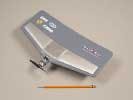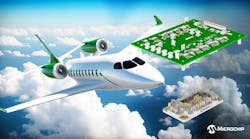By John McHale
ARLINGTON, Va. — Engineers from the U.S. Defense Advanced Research Projects Agency (DARPA) in Arlington, Va., are using multifunctional structure/power materials to build wings that provide lift as well as power for their WASP Micro Air Vehicle (MAV).
The idea behind the DARPA research is to build MAV wings that also function as the batteries, which cut down on aircraft weight and power, DARPA officials say.
The WASP design replaces separate battery and wing structure components with a multifunctional structure/battery material system that supplies electrical energy for propulsion while carrying mechanical and aerodynamic wing loads, says Leo Christodoulou, DARPA program manager. Only one third of the wing is the battery, but more can be added if necessary, Christodoulou says.
The WASP is the first in a series of developmental MAVs designed to show how multifunctional materials could enhance system performance, DARPA officials say. DARPA engineers recently set an endurance flight record during tests this summer with the new design. The WASP flew for one hour 47 minutes — more than three times the previous micro air vehicle endurance record of 30 minutes set two years ago.
The WASP is being developed under DARPA's Synthetic Multifunctional Materials (SMFM) program, which is exploring materials that combine the function of structure with another critical system function such as power, repair, or ballistic protection, Christodoulou says. The combination is to optimize system performance and improve or create new capabilities for military systems, he says.
The SMFM concept is based on the efficient, adaptable, and self-healing nature of bones and skin, Christodoulou says. The need is to combine an understanding of nature with developments in materials science, he explains.
The WASP is a radio-controlled vehicle with a 13-inch wingspan, and a combined wing/battery weight of 4.2 ounces. The total weight of the vehicle is 170 grams, or six ounces. The vehicle uses off-the-shelf components and lithium-ion batteries, which produce the highest energy density among all rechargeable battery systems, Christodoulou says. The energy density of the battery structure was 143 watts per kilogram, with an average output power of more than nine watts during the flight.
The new design is also not a one-size fits all approach, Christodoulou says. Engineers can design different versions of the MAV based on the mission required. The structural materials bring much more flexibility to designers, he explains. The materials may also one day be used in laptop computers to make the laptop's case its battery, Christodoulou adds.
The WASP is stable and simple to fly using manually operated ground control of the aircraft's throttle, rudder, and elevator surfaces, DARPA officials say. The next generation of WASP will use a simple autopilot and carry a color video camera.
MAVS such as the WASP will be able to maneuver like a mosquito through battlefields to spy on the enemy, detect toxic chemicals, or sting an enemy with a poison needle. In a military role, these six-inch machines will be able to retrieve visual, chemical, and biological target information.
Engineers at AeroVironment Inc., in Simi Valley, Calif., performed the aircraft design, fabrication, and flight test. Experts at Telcordia Technologies of Red Bank, N.J., contributed to the conceptual design of the wing structure-battery and supplied the custom-designed, plastic lithium-ion battery materials (PLiONTM battery cells), which were incorporated into the WASP wing.
Engineers at the Naval Research Laboratory in Washington contributed to the conceptual design of the wing structure-battery and helped to coordinate the prototype development.




